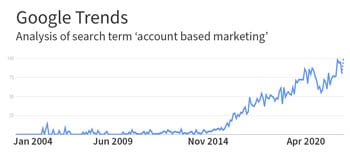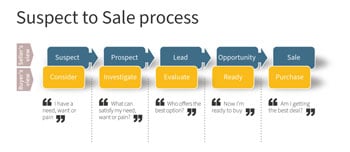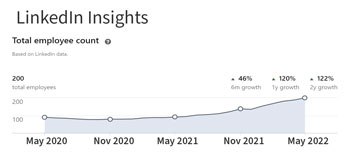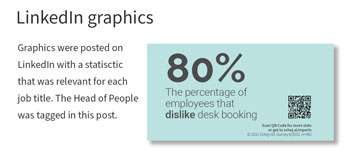Much is being written and discussed about Account Based Marketing. Not sure what all the fuss is about because ABM has been around for decades. It’s not as new as you might think. I’ll detail how I did it in a recent campaign.
ITSMA claimed to have coined the phrase Account Based Marketing (ABM) back in 2003, but people didn’t start searching (and therefore learning) about ABM until 2016. Its popularity around the world seems to have dramatically increased recently (see chart).
But in my experience ABM was being practised way back in the 1980s. It was called a ‘target list’ in those days.
Sales and marketing would get together and build a list of key organisations to be targeted. This was a method widely used in sectors with high-value orders and a limited audience.
The target list was then approached jointly by marketing and sales. The only difference between ABM and a target list is the tools now available (big data, marketing automation, social media etc).
Let me take you through a recent ABM programme I created for a SaaS start-up…
Identifying the targets
The SaaS start-up had built an app that optimises hybrid working. It makes it easier for firms to manage staff who sometimes work remotely and sometimes in the office.
I had already conducted some marketing for the company and there were various organisations at each stage of the Suspect-to-Sale process (or if you prefer, ‘the marketing funnel’). There were 70 prospects, 25 leads and 3 opportunities. We ignored suspects as they didn’t show sufficient engagement (see diagram).
If you are starting from scratch and have no prospects, leads or opportunities then identify the organisations most likely to buy your product. Your ideal targets. You should have listed their characteristics in your marketing plan. Start small, a list of 25-50 companies.
Alternatively, look at your existing clients. What behaviour did they display before they became a client? Had they won a major new customer, gone on a big recruitment drive or merged with another organisation? Discover common patterns in behaviour and then find new companies that are doing the same. That’s an ABM target list.
I examined the 98 firms on the list to see whether we had a full list of contacts at each company. We didn’t.
So the next stage was to map the buying team. We had previously agreed the key decision-makers and influencers at any organisation would be the CEO, COO, CPO/HR, CTO/CIO and Office Manager. In most cases, we only had 3 out of the 5 key contacts.
The process of adding additional contacts to each company also highlighted that some of our data was out of date. People had left, changed roles or been promoted. So this became a worthwhile data cleansing exercise as well.
Understanding their DNA
The next stage was to understand the DNA of each target organisation. What could be their needs, wants and pains? How are they organised? What news is there about their company?
Let’s take a real-world example. InitialE was one of the companies we were targeting. I searched for news on the organisation and found they had received Series C investment in October 2021 ($60m). Shortly after, they went on a hiring drive – increasing their workforce by 120% in 12 months (see chart).
Unfortunately, they also had a high staff churn rate. The average length of stay was 7 months.
In addition, the job adverts they posted were a mix of hybrid, remote and office-based roles across 4 worldwide sites. A real mixed bag.
Plus their founders had recently changed roles. The CEO became CTO, and the COO became CEO.
So the synopsis was that InitialE were going through a rapid period of growth with major changes at the top, plus new staff with differing working arrangements and a high staff churn. A major headache for the COO and Head of People.
But it’s these granular insights that enabled us to craft highly relevant messages for each member of the buying team at InitialE.
Another important aspect of this process is that you exclude companies who are not a good fit or where there isn’t a hook you can mention in your messaging.
Creating bespoke messages
We wanted to use channels that could deliver personalised messages to each of the contacts, so email and LinkedIn seemed the obvious choice.
A sequence of 4 emails was delivered to each of the 5 job titles over 4 weeks (important to have a gap of 5 working days between each email to avoid it looking like spam). The call to action was to identify the person(s) responsible for hybrid working and for them to book a demo.
In addition, each of the 5 contacts was tagged into graphics we posted on LinkedIn. Each graphic was relevant to their job title (see example).
This process is repeated for each of the 98 ABM target organisations.
ABM enables you to create very bespoke messages for each person you contact. It’s more effort but the results are worth it.
Sticking with the example of InitialE, we decided the core message was how our app could help them manage a hybrid workforce during rapid growth. We felt this would resonate with the company.
But for each job title we tweaked the message to make it even more relevant to their needs, wants & pains:
CEO: Founder, new CEO role. Pain = reducing staff churn to speed growth. Need = maintain a great culture.
CTO: Founder, new CTO role. Want = how technology can help manage the challenges of rapid growth.
COO: 2 years at InitialE. Need = optimising office capacity with a fluid workforce.
Head of People: 2 years at InitialE. Pain = attracting and retaining staff that want hybrid working.
People Operations Coordinator: Recently promoted (formerly Office Manager). Need = managing the day-to-day office capacity.
Managing the output
There are platforms that can do ABM at scale, but they can be expensive for a start-up company. For many bootstrapped start-ups, ABM is a manual process. As a result, the numbers have to be manageable.
In this campaign, we were eventually contacting one company per day. That was the maximum capacity.
But remember, we were emailing 5 people at each company with a series of 4 emails each. Each email was fully bespoke. And you need to allow time to handle the response.
Test and learn your Account Based Marketing
You won’t get ABM right first time. As with all forms of marketing, you will need to test and learn.
One of the learnings of this campaign was how time-consuming it can be. It took 3 days to set up the first company we contacted. After that, some templates were created and it took a day per company to research their DNA and create multiple bespoke messages and graphics. Don’t rush it.
Photo by Rupert Britton




